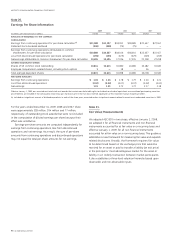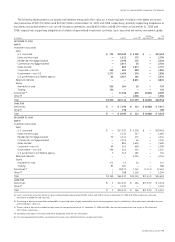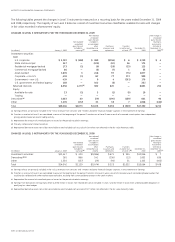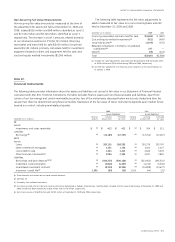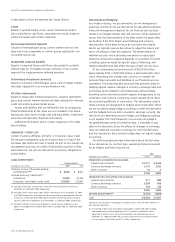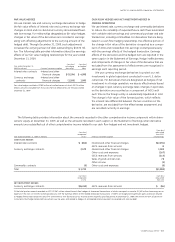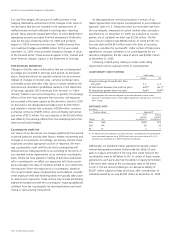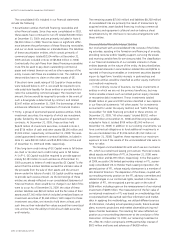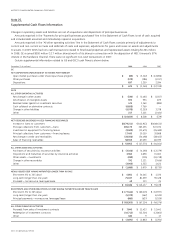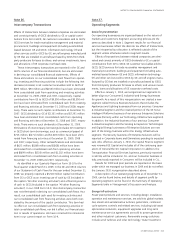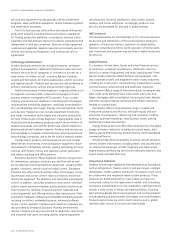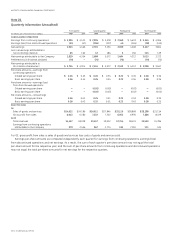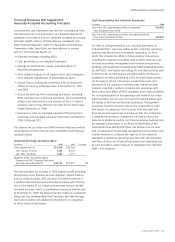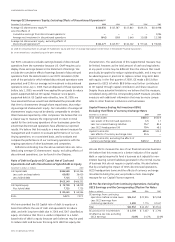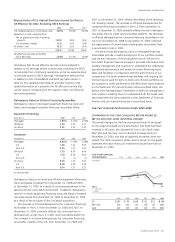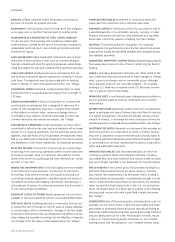GE 2009 Annual Report Download - page 110
Download and view the complete annual report
Please find page 110 of the 2009 GE annual report below. You can navigate through the pages in the report by either clicking on the pages listed below, or by using the keyword search tool below to find specific information within the annual report.
108 GE 2009 ANNUAL REPORT
Retained Interests in Securitization Transactions
When we transfer financing receivables, we determine the fair
value of retained interests received as part of the securitization
transaction. Further information about how fair value is determined
is presented in Note 1. Retained interests in securitized receivables
that are classified as investment securities are reported at fair
value in each reporting period. These assets decrease as cash is
received on the underlying financing receivables. Retained interests
classified as financing receivables are accounted for in a similar
manner to our on-book financing receivables.
Key assumptions used in measuring the fair value of retained
interests classified as investment securities and the sensitivity of
the current fair value to changes in those assumptions related to
all outstanding retained interests at December 31, 2009 and
2008 follow.
(Dollars in millions) Equipment
Commercial
real estate
Credit card
receivables
Other
assets
2009
Discount rate (a) 8.9% 17.0% 9.1% 5.4%
Effect of
10% adverse change $ (13) $ (12) $ (58) $ (1)
20% adverse change (25) (23) (115) (2)
Prepayment rate (a) (b) 23.8% 11.6% 9.9% 54.0%
Effect of
10% adverse change $ (5) $ (3) $ (54) $ —
20% adverse change (9) (6) (101) (1)
Estimate of credit losses (a) 0.9% 3.3% 15.0% 0.1%
Effect of
10% adverse change $ (7) $ (6) $ (207) $ —
20% adverse change (14) (11) (413) —
Remaining weighted
average asset lives
(in months) 9 51 9 39
Net credit losses for the year $153 $113 $1,914 $13
Delinquencies 132 212 1,663 61
2008
Discount rate (a) 17.6% 25.8% 15.1% 13.4%
Effect of
10% adverse change $ (15) $ (14) $ (53) $ (1)
20% adverse change (30) (26) (105) (3)
Prepayment rate (a) (b) 19.5% 11.3% 9.6% 52.0%
Effect of
10% adverse change $ (2) $ (3) $ (60) $ —
20% adverse change (5) (7) (118) (1)
Estimate of credit losses (a) 0.7% 1.3% 16.2% —%
Effect of
10% adverse change $ (5) $ (2) $ (223) $ —
20% adverse change (10) (4) (440) —
Remaining weighted
average asset lives
(in months) 14 55 10 4
Net credit losses for the year $ 89 $ 28 $1,512 $ 5
Delinquencies 123 260 1,833 80
(a) Based on weighted averages.
(b) Represented a payment rate on credit card receivables, inventory financing
receivables (included within equipment) and trade receivables (included within
other assets).
Activity related to retained interests classified as investment
securities in our consolidated financial statements follows.
(In millions) 2009 2008 2007
CASH FLOWS ON TRANSFERS
Proceeds from new transfers $10,013 $ 6,655 $22,767
Proceeds from collections reinvested
in revolving period transfers 61,364 70,144 61,625
Cash flows on retained interests
recorded as investment securities 7,027 5,935 4,265
EFFECT ON GECS REVENUES
FROM SERVICES
Net gain on sale $ 1,589 $ 1,133 $ 1,805
Change in fair value of retained
interests recorded in earnings 291 (113) (102)
Other-than-temporary impairments (133) (330) (114)
Derivative Activities
In connection with some securitization transactions, the QSPEs
use derivatives to manage interest rate risk between the assets
they own and liabilities they issue. In such instances, at the
inception of the transaction, the QSPE will enter into a derivative
that generally requires the payment of a fixed rate of interest to
a counterparty in exchange for a floating rate of interest in order
to eliminate interest rate, and in certain instances, payment speed
volatility. In some cases, a GE entity is the counterparty to a QSPE’s
derivative; the fair value of such derivatives was a net asset of
$454 million and $752 million at December 31, 2009 and 2008,
respectively. In such cases, a second derivative is executed with a
third party to minimize or eliminate the exposure created by the
first derivative.
Servicing Activities
As part of a securitization transaction, we may provide servicing
in exchange for a market-based fee that is determined on princi-
pal balances. Where the fee does not represent market-based
compensation for these services, a servicing asset or liability is
recorded, as appropriate. The fair value of the servicing asset or
liability is subject to credit, prepayment and interest rate risk.
Servicing assets and liabilities are amortized to earnings in propor-
tion to and over the period of servicing activity. The amount of
our servicing assets and liabilities was insignificant at December 31,
2009 and 2008. We received servicing fees from QSPEs of
$608 million, $641 million and $566 million in 2009, 2008 and
2007, respectively.
When we provide servicing we are contractually permitted
to commingle cash collected from customers on financing
receivables sold to investors with our own cash prior to payment
to a QSPE provided our credit rating does not fall below levels
specified in each of our securitization agreements. Based on our
current credit rating we do not anticipate any restriction to
commingling cash under these arrangements. At December 31,
2009 and 2008, accounts payable included $5,007 million and
$4,446 million, respectively, representing obligations to QSPEs for
collections received in our capacity as servicer from obligors of
the QSPEs.
Included in other GECS receivables at December 31, 2009
and 2008, were $3,526 million and $2,346 million, respectively,
relating to amounts owed by QSPEs to GE, principally for the
purchase of financial assets.


